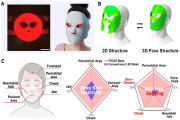Osram Opto Semiconductors’ new SFH 4787S infrared
LED (IRED) for iris scanners illuminates the eyes so evenly that the software identifying the iris pattern now hardly needs to correct artefacts.
New Oslux IRED ensures even illumination, simplifying identification of unique iris patterns.
(Osram/ LEDinside)
Like its predecessor (SFH 4786S), its direction of emission is slightly angled rather than vertical, thus simplifying the design process by eliminating the usual mechanical aids. Osram Opto Semiconductors will be presenting the new SFH 4787S IRED at the upcoming Mobile World Congress.
Iris recognition is among the most reliable biometric identification methods available today. With this safeguard, iris scanners illuminate the user’s eyes with infrared light and a camera takes a photograph. Special software then analyzes this photo to detect the iris pattern, which is unique to each individual. Once confirmed, the device is unlocked for the user.
Two years ago, Osram Opto Semiconductors was first to market an infrared LED (the SFH 4780S) that brought this technology to smartphones and other mobile devices. This was followed by a version with a slightly angled direction of emission (SFH 4786S), which meant that designers no longer needed mechanical aids to tilt the entire LED to align the angle of emission with the camera’s field of view.
(Osram/ LEDinside)
Even illumination simplifies processing
The key feature of this third-generation Osram IRED for iris recognition is its flat intensity distribution, optimizing the reflector and lens to ensure virtually constant intensity across the emitted light beam. With this technology advance, the brightness differences in the camera images originate only from the iris pattern and are not additionally generated by a gradient in the illumination.
The software then needs to correct fewer artefacts when determining the iris pattern, increasing accuracy in analysis and detection.
Apart from this, the SFH 4787S is almost identical to its predecessor, the SFH 4786S. Both are based on the compact 3.5 x 3.5 x 1.6 millimeter Oslux package. A wavelength of 810 nanometers (nm) delivers high-contrast images for all eye colors.
The emission direction is tilted by 8°, while the emission angle is ±18°. The optical output of this highly efficient emitter is 720 milliwatts (mW) at a current of 1 amp, with a radiant intensity of 1,000 milliwatts per steradian (mW/sr).
Industrial applications gaining ground
The impetus to develop more compact and reliable iris scanners was driven by the need for dependable solutions to safeguard mobile devices from unauthorized access. Gradually, the technology is making its way into other sectors.
“Access control as a whole is becoming increasingly important and iris recognition remains one of the most reliable methods available,” explains Eric Kuerzel, Product Marketing Manager at Osram Opto Semiconductors. “There are a variety of industries following in the footsteps of the consumer markets by incorporating iris recognition for access control and other functions.”





 CN
TW
EN
CN
TW
EN







